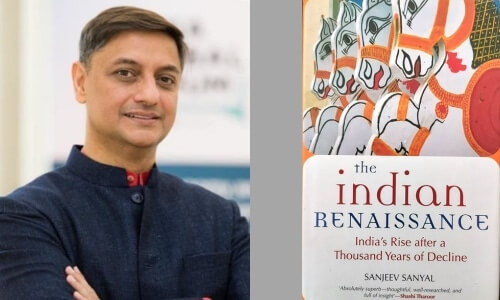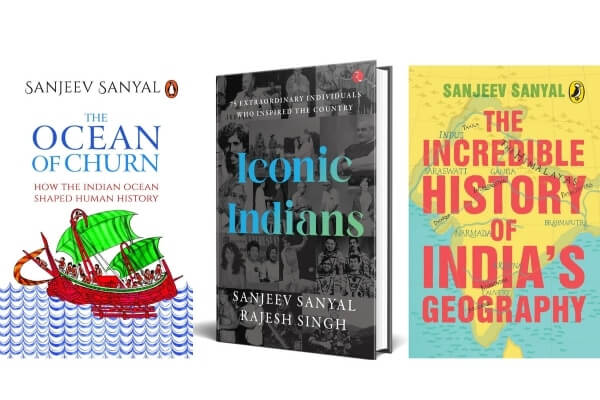When Stewart Gordon’s seminal work When Asia was the World was published in 2007, it was a recognition of sorts that Asia was on the threshold of regaining the status it once held as the centre of the world. A thousand years ago – China, India and Arabia were linked by myriad connections, were intellectually curious, AND dominated trade and manufacture when Europe was shrouded in the ‘dark’ ages. Asia – especially India and China – however succumbed to colonialism, shook it off centuries later, and adopted import-substituting economic models before opening up their economies in the 1990s and forging ahead. Sanjeev Sanyal’s book The Indian Renaissance: India’s Rise After a Thousand Years of Decline (first published in 2008 and paperback in 2015 by Penguin India) believes that India’s time has come, and that the country is reawakening not only as an economic powerhouse, but also as a civilisation. After a thousand years of decline, it has a real chance to re-establish itself as a major power.

India’s economy is growing exponentially, and the best is yet to come, argues Sanyal, insisting that 1991 was as historic a moment in India’s history as 1947, for it unleashed India’s potential for the first time in a thousand years. It is hard to believe now, that from 1947 to 1991, most thinking people in India believed that the import-substitution model was the right one, with the brilliant statistician Mahalanobis being of the opinion that the five-year plans designed to implement that model just needed to be executed properly – the debate was not over whether it was the right model at all! Sanyal examines how India came to be at this juncture, the reforms it still needs to engender, and what the future holds.
Sanjeev Sanyal’s books have seen him emerge as an Indian intellectual par excellence – straddling several genres. He spent his early working life in the thick of international finance in Mumbai and then Singapore. In 2008 he returned to India and travelled the length and breadth of the country, resulting in his second book Land of the Seven Rivers (2012). He trekked to remote mountain passes, delved into ancient archaeological sites, perused old manuscripts – in order to explore how the country’s history has been shaped by its rivers, mountains and cities – among other things. In the process he answers umpteen questions with wit and perception. Three years later he published The Incredible History of India’s Geography (2015) in which he explored matters to do with India’s landscape and geography. It’s full of interesting trivia while at the same time taking us through a fantastic journey of Indian history through its geography.

In 2016 Sanyal turned his attention to the Indian Ocean and published The Ocean of Churn: How the Indian Ocean Shaped World History. This is the first book since Sawant Subramanian’s Following Fish: Travels Around the Indian Coast (2013) by an Indian writer that has focussed on the Indian Ocean region. Sanyal casts his net a little wider than Subramanian both historically and geographically, and covers topics as wide as the first human migrations out of Africa, to the Vijayanagar Kingdom to Angkor Wat; Arab traders to Chinese fleets right up to the advent of the Europeans.
Sanyal by now had cut a swathe in intellectual circles, and he was picked in 2017 to join the Economic Advisory Council of the Ministry of Finance, and in 2022 was inducted into the PMO as the Principal Economic Advisor.
Fast forward a few years, and Sanyal trained his guns on a different genre, putting together a collection of essays: Iconic Indians:75 Extraordinary Individuals Who Inspired the Country (2022), with Rajesh Singh, celebrating 75 Indians who have played a pivotal role in transforming India into a confident nation it is today. While most of us would be familiar with many of the names here, there are some whose contributions were massive, but have since been forgotten.
Last year Sanyal published Revolutionaries: The Other Story of How India Won Its Freedom. Sanyal believes that the armed struggle against colonialism was a continuous one from the very beginning of colonial occupation – and not an ad hoc effort of a few individuals. He argues that the revolutionary struggle operated through a network that encompassed thinkers and institutions, and enjoyed popular support. As Subhas Chandra Bose’s popularity demonstrated, there were times they could defeat other candidates even within the Congress Party. Sanyal unearths some exciting revolutionaries and their modus operandi, juxtaposing their heroism and courage against a backdrop of high drama, intrigue, espionage, and such. I was reminded of Tim Harper’s brilliant book Underground Asia: Global Revolutionaries and the Assault on Empire (2020) which explored the lives of twentieth century’s revolutionaries such as Hon Chi Minh, M.N.Roy, et al.

Whether one agrees with everything that Sanyal says or not, he is an intellectual giant who straddles several disciplines with ease.
When one throws in his eclectic education (he was a Rhodes scholar), work and travels (he backpacked in South America in his 20s), Sanjeev Sanyal’s books make for some incisive and perceptive observations.
Definitely a thinker and writer to follow.
READ ALSO: Ajay Bisaria’s ‘Anger Management’: On India-Pak diplomacy




